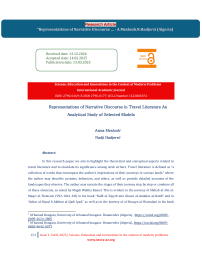Representations of Narrative Discourse in Travel Literature An Analytical Study of Selected Models
Автор: Asma Mesloub, Nadji Hadjersi
Журнал: Science, Education and Innovations in the Context of Modern Problems @imcra
Статья в выпуске: 1 vol.8, 2025 года.
Бесплатный доступ
In this research paper, we aim to highlight the theoretical and conceptual aspects related to travel literature and to elucidate its significance among Arab writers. Travel literature is defined as “a collection of works that encompass the author’s impressions of their journeys in various lands,” where the author may describe customs, behaviors, and ethics, as well as provide detailed accounts of the landscapes they observe. The author may narrate the stages of their journey step by step or combine all of these elements, as noted by Magdi Wahba Kamel. This is evident in the journey of Shihab al Din al Maqri al Tlemceni (992 1041 AH) in his book “Nafh al Tayyib min Ghusn al Andalus al Ratib” and in “Azhar al Riyad fi Akhbar al Qadi Iyad,” as well as in the journey of al Husayn al Wurtalani in his book “Nuzhat al Anzar fi Fadl Ilm al Tarikh wa al Akhbar,” where al Wurtalani describes these places, their people, scholars, and customs. This includes his performance of the pilgrimage, describing Mecca, Medina, and other locations. Additionally, we explore the works of Amin al Rihani and Muhammad Umar al Tunisi (1789-1857) and others. In the Arab East, we examine the journey of Ahmad Faris al Shidyaq in his first book, “Kashf al Makhba ‘an Funun Awropa,” where he discusses the pathways and topography of Europe, along with its distinctive customs, traditions, and ways of living. His second book, “Al Wasita fi Ma’rifat Ahwal Malta,” describes the island of Malta, its history, geography, and civilization, highlighting the key customs, ethics, and languages of its inhabitants. Undoubtedly, each journey from these travelers provides an opportunity to delve into the manifestations of narrative discourse and its reflections in the works of Muhammad ibn Ahmad ibn Jubayr (540 614 AH) in his journey titled “Tadhkirah bil Akhbar ‘an Ittifaqat al Asfar” and in the works of Abu Abdullah Muhammad (703 776 AH), known as Ibn Battuta, in his journey titled “Tuhfat al Nazar fi Gharayib al Amsar wa ‘Ajayib al Asfar.” We will utilize a critical analytical approach to uncover the secrets and depth of these texts.
Discourse, Travel Literature, Narrative Discourse, Literary Genres
Короткий адрес: https://sciup.org/16010326
IDR: 16010326 | DOI: 10.56334/sei/8.1.19


